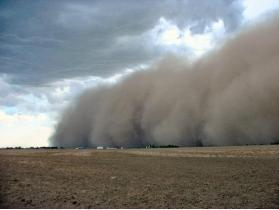The new floods and draughts
Dust storms scour Iraq. Freak floods wreak havoc in Saudi Arabia and Yemen. Rising sea levels erode Egypt's coast. Tuvulu and the Seychelles may disappear altogether as hey submerge into the ocean.
 |
|
Sand storm |
A comprehensive vulnerability index suggests you move to Scandinavia, Ireland or Iceland as slightly safer places. The teeming plains of Asia are at greater risk in the next 30 years. Ten of the 16 most vulnerable countries are in Asia where high populations, low lying land and potential water shortages will plague more than other places and people.
High Asia is dominated by many steep, dramatic mountain ranges that run through parts of Nepal, Bhutan, Afghanistan, India, China, Tajikistan, Kyrgyzstan and other countries.
The region is home to more than 50,000 glaciers that are vital water lifelines to Asia's largest rivers, including the Yellow, Yangtze, Mekong, Indus and Ganges. Roughly two billion people depend on these rivers for their water and food supply. What happens when all this changes with the climate?
The Climate Change Vulnerability Index was produced by Maplecroft, a British risk analysis firm. It crunched data in October 2010 from more than 40 different studies, and looked at a range of risk factors including a nation's exposure to climate-related disasters; its population density, poverty and dependence on agriculture; and its government's and infrastructure's ability to adapt to climate change.
Bangladesh comes top of the "extremely vulnerable" category because of its large population, extreme rural poverty and high risk of flooding. Bangladesh is a low lying delta land on the edge of the Indian Ocean.
India is second because of its billion-plus inhabitants. It relies on Himalayan water sources that may dry up.
African nations judged at extreme risk are Madagascar, Mozambique, Zimbabwe, Ethiopia and Malawi. This is primarily based on their poverty level and relatively primitive farming techniques.
Tuvalu and Kiribati are two of the places on earth that are most vulnerable to the affects of global warming. The threat of sea level rise may bring complete disaster to the 10,000 Tuvaluans residing on nine extremely low-lying coral atolls (Maximum height of 15 feet). Though these small nations may disappear, their only saving grace is their low populations.
Unfortunately, many people who live in High Asia and along the river basins (such as the heavily populated Indus valley) fed by the region's glaciers already experience malnutrition and food insecurity, insufficient access to clean water and sanitation, and other issues that will be exacerbated by climate change and population growth. The challenge is to incorporate climate change into their existing development efforts so that quality of life continues to improve in the developing world.
Although the world's glaciers have slowly been retreating since 1850 — the end of what climate scientists refer to as the Little Ice Age — those in High Asia have not melted as quickly, mostly due to the glaciers location in elevations higher and colder than many other glacier systems.
The Battelle report (Changing Glaciers and Hydrology in Asia: Addressing Vulnerability to Glacier Melt Impacts) states that many Himalayan glaciers are retreating, especially at the lower elevations, but that no region-wide evidence supports the claim that they're retreating faster than any other location in the world. The report also recommends that scientists collaborate internationally to gather more information to show the glaciers' overall ice balance on a regional scale.
Retreating glaciers can also heighten existing water worries. In the Indus River Basin, for example, glacier melt accounts for about 30 percent of the river's water supply. Retreating glaciers would lessen the river's overall flow, but that impact would likely be more dramatic as the region's population growth increases the demand for water. The Indus River Basin is already home to more than 200 million people, and the region's high fertility rates mean its population will continue to grow rapidly. As a result, the region's per capita water availability will decline steeply. The issue is compounded by the large amount of irrigated land there.
Human health also stands to be affected by climate change in High Asia. Less available water could mean higher pollution levels and increased difficulty obtaining clean water and sanitation "for hundreds of millions in these watersheds," reads the report. Diarrhea and other diseases linked to biological and chemical contamination are likely, the report notes.
 0
0 






